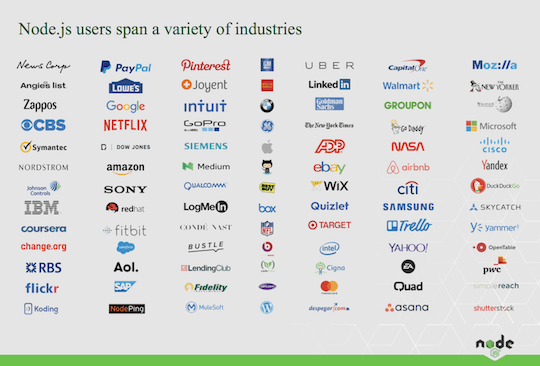
Discover one of the most powerful technologies for web development used by Paypal, Netflix, Uber, and Twitter. Learn what you can build with Node.js and see if it’s a good choice for your project.
Node.js is gaining more and more popularity. The 2018 Node.js User
Survey Report shares insights from more than 1600 participants. Three
quarters of them say that they’re planning to increase their use of Node
over the next 12 months. Node is most commonly used in web app
development, with 85% of respondents indicating they use it for this type
of work. 43% of respondents indicate they use Node for enterprise
applications.
As stated in the report:
Node.js is continuing to have a positive impact on users
particularly around developer productivity and satisfaction;
when asked to describe Node.js, respondents use mostly
positive terms like – “fast”, “easy”, “awesome”, “powerful”,
“flexible” and even “fun”.

Node.js is gaining popularity and it is used among a variety of industries.
We are aware of its advantages, but when can we actually make use of
them? Let’s see what types of applications can be built with Node.js!
A real-time chat is any type of communication tool that enables real-time
exchange of text messages, voice or video calls, etc. These can be one to
one or group chats in IM (instant messaging) or IRC (Internet Relay Chat)
technologies. Real-time chats are widely popular anywhere on the
internet – especially with the giant popularity of social networking apps.
Node.js is the perfect solution for real-time chats. The asynchronous
nature of this runtime brings powerful Event API that allows usto work in
event-driven approach almost with any data. This functionality clears the
way for implementing server-side events and push notifications that are
common in real-time communication applications. Node’s architecture
works well with the WebSocket protocol, which is important for the fast
exchange of messages between the client and the server via a single
open connection. If you implement WebSockets both on the client
and the server side, you can create real-time messaging withfaster data
transfer and lower latency.
A single-page application (SPA) is a web app that fits into one page.
It rewrites the current page (or even fragment of that page) instead of
loading new pages from the server. SPAs are commonly used e.g.
in social media platforms. Since Node.js handles asynchronous calls and
heavy I/O workloads efficiently, it is well-suited for SPAs. Utilizing
Node’s approach to efficiently handle many things at once, it is a perfect
condition to fulfill many requests with small chunks of data sent often to
the front-end application. This means that what the users see transitions
in a way that is subtle and consistent so that they don’t have to wait
to interact with the app.
Additionally, most SPAs use frameworks such as Angular, Meteor, Vue or
React – all JavaScript frameworks. As Node.js is also written in JavaScript,
developers can use the same data and language structure on the server
and the client side.This speeds up the development and makes the
SPA easier to maintain.
Application streaming is a form of on-demand software distribution. This
means that only some essential elements of the app have to be
downloaded and installed on the device, all other parts can be
downloaded later when they’re needed. This can bring users to
the application quickly, without letting them wait until the download of
a huge amount of data is done. You could ask: Where’s Node’s
advantage in this?
Node handles data streaming extremely well. It achieves that by having
many tools built exclusively to handle, monitor, and process streams,
and by doing that efficiently. All of that contributes to an excellent
environment to work with streaming data.
There’s a whole variety of collaboration tools available on the market:
Trello (and other) for project management, Google Docs for collaborative
editing of documents, Hangouts for conferencing. These and many more
tools make it possible for a team to share a workspace and collaborate
even if they don’t work in one office. Or even one country for that matter.
All of these collaboration tools are real-time, so (similarly to real-time
chats) Node’s asynchronous and event-based architecture plays
a significant role. Again, many events and requests occur at the same
time – multiple users can be editing the same file, moving tasks between
the boards in Trello, commenting, adding media files. Node’s
WebSockets and event API make sure that the operations performed by
multiple users do not negatively impact the server and that all server-side
data is delivered back to the client with no delay. Node’s role is to ensure
that all of the users see the same view, with all the updates applied.
The Internet of Things (IoT) is anything that connects to the internet and
shares data. These can be sensors, beacons, and many more – as long as
the device exchanges data and shows information in an electronic form.
The normal transfer of data in IoT is from the device to the server and
from the server to an app which can process the information and display
it to the user.
The importance of Node.js here lies in the fact that it allows the
processing of multiple concurrent requests and a vast number of
devices (even millions!) on the network. Node’s event-driven
architecture and asynchronous processing help process all the requests
and don’t block Node’s servers. Node.js constitutes an efficient
application layer between the IoT devices and the databases that store
the information gathered from these devices.
Well, maybe not literally ‘anything’ but the list of Node’s advantages is
quite extensive. If the app you want to build needs to handle multiple
concurrent requests, heavy I/O workloads or frequent data shuffling,
Node.js is definitely the right choice for you.
Sign up and start getting curated content about Node.js and other JS technologies. Read about different challenges related to app development and see how to overcome them.